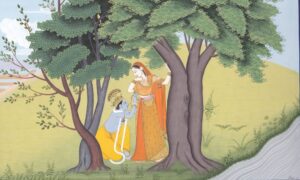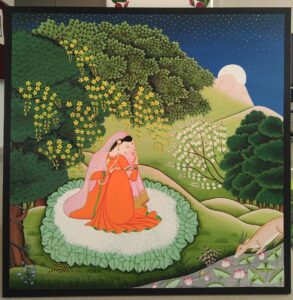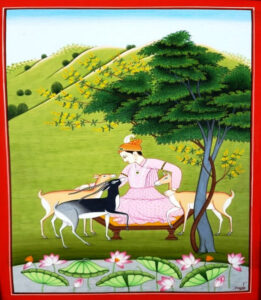Kangra Paintings: Discovering the Rich Artistic Heritage of India
Kangra Miniature painting, one of the schools of Pahari paintings alongside Guler, Basholi, Mandi, Chamba, Arki, and Bilaspur, has a rich history deeply rooted in the scenic hills of Himachal Pradesh. Originating from Guler and later flourishing in Kangra, these paintings offer a captivating glimpse into the region's vibrant culture and heritage. Remarkably, despite the passage of over 300 years, these artworks have retained their breathtaking brilliance, enchanting viewers worldwide.
History of Kangra Paintings:
Late 17th Century
Decline of the Mughal Empire: As the Mughal court's influence waned, painters migrated to the more stable regions in the hills, setting the stage for the Pahari school of painting.
Early 18th Century
Origin of Kangra School: The school initially emerged in Guler during the reign of Raja Goverdhan Chand (1745-1773 AD), a prince known for his refined artistic taste and passion for painting.
Mid 18th Century
Integration with Kangra: Guler was absorbed into Kangra, which was ruled by Raja Sansar Chand. His reign marked a significant era as he provided generous patronage, leading to a golden age for the Kangra School.
Late 18th Century to Early 19th Century
Golden Age of Kangra Paintings: Under Raja Sansar Chand's patronage, the region experienced a flourishing of artistic expression, defining the characteristics of Kangra paintings.
Development Influences in Kangra Paintings:
Mughal Painting Techniques: Adoption and adaptation of refined Mughal painting methods.
Vaishnavism: Predominantly featuring themes around the romantic tales of Lord Krishna.
Sanskrit Poetry: Drawn inspiration from classical Sanskrit poetry, lending a lyrical quality to the art.
Local Beauty: Influenced by the beauty of local people and landscapes of Kangra Valley and Punjab Hills.

Themes and Techniques of Kangra Paintings:
Central Themes: Focus on the eternal love story of Lord Krishna and Radha, along with other themes from Hindu mythology, nature, and the changing seasons.
Artistic Characteristics:
- Delicate Lines and Vibrant Colors: Known for fine detailing and the use of vibrant, pure colors derived from minerals and vegetables.
- Natural Motifs: Frequent depiction of brooks, rivulets, and the ethereal beauty of the female form.
Materials and Craftsmanship:
- Natural Colors: Utilization of 19 natural colors made from local resources found in the Kangra valley, such as stones and plants. These colors require a year to prepare as they depend on seasonal availability.
- Gold Application: Use of gold to add luster and richness to the paintings.
- Innovative Techniques: Use of natural poison from slow fire residue (Dhuna) and paper made from leftover pine tree materials.
- Local Brushes: Brushes crafted from the wings of Turtle Doves, a local bird species.

Characteristics of Kangra paintings
Kangra paintings are known for their lush green landscapes, capturing the beauty of nature with intricate detail. The style is lifelike, showing a lot of attention to small details. You'll see a wide range of green shades, showing different types of plants and trees, along with streams and brooks
Kangra artists used soft, delicate colors, like light pink for faraway hills. They played with shades of primary colors to create a fresh, gentle look.
These paintings often portray women with elegance and grace. Their facial features are gentle and refined, making them exceptionally beautiful.
Significance of Kangra paintings
The three main centers of Kangra painting are Guler, Nurpur and Tira-Sujanpur. Painting depicts ideas and values which guided life in society, sentiments and passions pictured in the language of brush and color make our experience rich and sensibilities sharp .
Despite being historically important and beautiful, Kangra paintings are at risk of disappearing forever. The fast growth of cities and the influence of modern life are big problems. We're seeing the slow loss of old ways and culture, so it's super important to act fast to save Kangra paintings for the next generations. We need to spread awareness and help local artists. By understanding how valuable Kangra paintings are and working together to preserve them,we can make sure their beauty and stories live on for a long time.
Today, Kangra art is a peaceful tribute to life and its simplicity, using realistic colors inspired by nature.
Main Paintings and Painters :
Under the generous patronage of Raja Sansar Chand, the Kangra school of painting reached its zenith during the late 18th century. This era witnessed the creation of exquisite miniature paintings that drew inspiration from notable literary works such as Jaydeva’s "Gita Govinda," "Bihari’s Sat Sai," and Keshav Das' "Raskapriya" and "Kavipriya."
A group of talented artists, including Manku, Khushala, Kishan Lal, Basia, Purkhoo, and Fatoo, played significant roles in the development and proliferation of this art form between 18th & 19th Century. These artists, alongside Raja Sansar Chand’s son Ramdyal, contributed richly to the legacy of Kangra painting, infusing their works with the delicate finesse and vibrant colors characteristic of this style.
The artistry of Kangra paintings was further immortalized by Nainsukh and Manaku, sons of the illustrious Pandit Sau, a former painter from the Guler state. Their masterpieces not only highlight the aesthetic and thematic sophistication of Kangra art but also enjoy prestigious placements in international collections, including the Reitberg Museum in Zurich, the London Museum, and the Boston Museum in the USA.
These contributions collectively underscore the artistic brilliance and cultural significance of Kangra paintings during its golden age, propelled by the vision and support of Raja Sansar Chand.

Recognition and Preservation:
In 2012, Kangra painting was granted Geographical Indication status, recognizing its cultural significance and ensuring its preservation for future generations. Today, these exquisite miniatures adorn museums and private collections across the globe, serving as proud ambassadors of India's artistic heritage. Notably, in 2022, Prime Minister Narendra Modi presented US President Joe Biden with a miniature painting of Kangra, showcasing its enduring appeal on the global stage.


